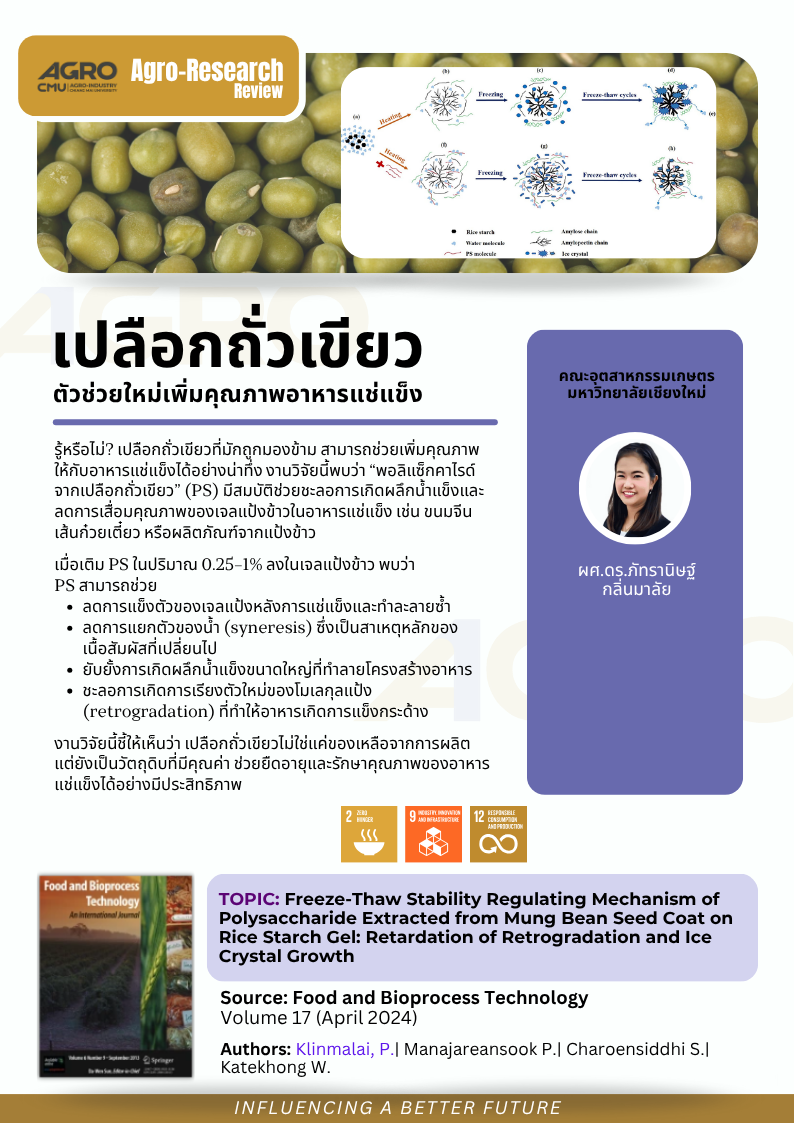
เปลือกถั่วเขียว ตัวช่วยใหม่เพิ่มคุณภาพอาหารแช่แข็ง
รู้หรือไม่? เปลือกถั่วเขียวที่มักถูกมองข้าม สามารถช่วยเพิ่มคุณภาพให้กับอาหารแช่แข็งได้อย่างน่าทึ่ง งานวิจัยนี้พบว่า “พอลิแซ็กคาไรด์จากเปลือกถั่วเขียว” (PS) มีสมบัติช่วยชะลอการเกิดผลึกน้ำแข็งและลดการเสื่อมคุณภาพของเจลแป้งข้าวในอาหารแช่แข็ง เช่น เส้นก๋วยเตี๋ยว ขนมจีน หรือผลิตภัณฑ์จากแป้งข้าว
เมื่อเติม PS ในปริมาณ 0.25–1% ลงในเจลแป้งข้าว พบว่า PS สามารถช่วย
- ลดการแข็งตัวของเจลแป้งหลังการแช่แข็งและละลายซ้ำ
- ลดการแยกตัวของน้ำ (syneresis) ซึ่งเป็นสาเหตุหลักของเนื้อสัมผัสที่เปลี่ยนไป
- ยับยั้งการเกิดผลึกน้ำแข็งขนาดใหญ่ที่ทำลายโครงสร้างอาหาร
- ชะลอการเกิดการเรียงตัวใหม่ของโมเลกุลแป้ง (retrogradation) ที่ทำให้อาหารเกิดการแข็งกระด้าง
งานวิจัยนี้ชี้ให้เห็นว่า เปลือกถั่วเขียวไม่ใช่แค่ของเหลือจากการผลิต แต่ยังเป็นวัตถุดิบที่มีคุณค่า ช่วยยืดอายุและรักษาคุณภาพของอาหารแช่แข็งได้อย่างมีประสิทธิภาพ
--
Did you know? The often-overlooked mung bean seed coat can significantly improve the quality of frozen foods! Recent research reveals that polysaccharides extracted from mung bean seed coats (PS) help slow down ice crystal formation and reduce deterioration in rice starch gels -commonly found in frozen products like rice noodles, including khanom jeen, and other rice-based products.
When PS is added at concentrations of 0.25–1%, it:
- Reduces gel hardening after freeze-thaw cycles
- Minimizes water separation (syneresis), which affects texture
- Inhibits the growth of large ice crystals that damage food structure
- Slows down starch retrogradation, which causes firmness and quality loss
These findings show that mung bean seed coats are not just industrial waste - they’re a valuable ingredient that can extend shelf life and preserve the texture of frozen starch-based foods.
Topic: Freeze-Thaw Stability Regulating Mechanism of Polysaccharide Extracted from Mung Bean Seed Coat on Rice Starch Gel: Retardation of Retrogradation and Ice Crystal Growth
Authors: Klinmalai, P.| Manajareansook P.| Charoensiddhi S.| Katekhong W.
Abstract:
The effect of mung bean seed coat polysaccharide (PS) on the physicochemical properties and freeze-thaw stability of rice starch (RS) gel was studied. Results showed that the addition of PS at concentrations of 0.25, 0.50, and 1.0% affected the physicochemical properties of RS. The onset gelatinization temperature of RS increased and the gelatinization enthalpy decreased with increasing the concentration of PS. PS caused a decrease in peak viscosity, breakdown, and setback but increase in pasting temperature. For the textural properties, PS at the concentration of 0.25, 0.50, and 1.0% reduced changes in RS gels hardness after 5 freeze-thaw cycles by 20.76, 35.91, and 47.57%, respectively, compared to the sample without PS. The syneresis of RS gels during freeze-thaw process was also reduced by the addition of PS especially at 1.0%. It is related with the results of ice crystal size when the addition of PS. Ice crystal image showed a dramatically reduced ice crystal size and modified ice shape influenced by PS. Retrogradation measurement, microstructure, and crystallinity of RS gels after repeated freeze-thaw cycles indicated the minimizing of starch retrogradation caused by PS. These results suggested that PS was effective in preserving quality in frozen rice starch-based products.
Keywords: Polysaccharide; Mung bean seed coat; Ice crystals inhibition; Rice starch; Freeze-thaw stability
View at publisher: https://link.springer.com/article/10.1007/s11947-024-03397-x
#อกมช. #agrocmu #CMU




